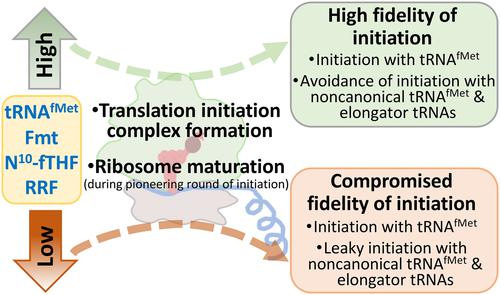当前位置:
X-MOL 学术
›
Mol. Microbiol.
›
论文详情
Our official English website, www.x-mol.net, welcomes your feedback! (Note: you will need to create a separate account there.)
Genetic analysis of translation initiation in bacteria: An initiator tRNA‐centric view
Molecular Microbiology ( IF 3.6 ) Pub Date : 2024-02-27 , DOI: 10.1111/mmi.15243 Kuldeep Lahry 1 , Madhurima Datta 1 , Umesh Varshney 1, 2
Molecular Microbiology ( IF 3.6 ) Pub Date : 2024-02-27 , DOI: 10.1111/mmi.15243 Kuldeep Lahry 1 , Madhurima Datta 1 , Umesh Varshney 1, 2
Affiliation

|
Translation of messenger RNA (mRNA) in bacteria occurs in the steps of initiation, elongation, termination, and ribosome recycling. The initiation step comprises multiple stages and uses a special transfer RNA (tRNA) called initiator tRNA (i‐tRNA), which is first aminoacylated and then formylated using methionine and N10 ‐formyl‐tetrahydrofolate (N10 ‐fTHF), respectively. Both methionine and N10 ‐fTHF are produced via one‐carbon metabolism, linking translation initiation with active cellular metabolism. The fidelity of i‐tRNA binding to the ribosomal peptidyl‐site (P‐site) is attributed to the structural features in its acceptor stem, and the highly conserved three consecutive G‐C base pairs (3GC pairs) in the anticodon stem. The acceptor stem region is important in formylation of the amino acid attached to i‐tRNA and in its initial binding to the P‐site. And, the 3GC pairs are crucial in transiting the i‐tRNA through various stages of initiation. We utilized the feature of 3GC pairs to investigate the nuanced layers of scrutiny that ensure fidelity of translation initiation through i‐tRNA abundance and its interactions with the components of the translation apparatus. We discuss the importance of i‐tRNA in the final stages of ribosome maturation, as also the roles of the Shine–Dalgarno sequence, ribosome heterogeneity, initiation factors, ribosome recycling factor, and coevolution of the translation apparatus in orchestrating a delicate balance between the fidelity of initiation and/or its leakiness to generate proteome plasticity in cells to confer growth fitness advantages in response to the dynamic nutritional states.
中文翻译:

细菌翻译起始的遗传分析:以起始 tRNA 为中心的观点
细菌中信使 RNA (mRNA) 的翻译发生在起始、延伸、终止和核糖体回收步骤中。起始步骤包括多个阶段,并使用一种称为起始 tRNA (i-tRNA) 的特殊转移 RNA (tRNA),它首先被氨酰化,然后使用蛋氨酸和 N 进行甲酰化。10 ‐甲酰基四氢叶酸(N10 ‐fTHF),分别。蛋氨酸和N10 ‐fTHF 通过单碳代谢产生,将翻译起始与活跃的细胞代谢联系起来。i-tRNA 与核糖体肽基位点(P 位点)结合的保真度归因于其受体茎中的结构特征以及反密码子茎中高度保守的三个连续 G-C 碱基对(3GC 对)。受体茎区对于 i-tRNA 上氨基酸的甲酰化及其与 P 位点的初始结合非常重要。而且,3GC 对对于 i-tRNA 穿过起始的各个阶段至关重要。我们利用 3GC 对的特征来研究细致入微的审查层,通过 i-tRNA 丰度及其与翻译装置组件的相互作用确保翻译起始的保真度。我们讨论了 i-tRNA 在核糖体成熟最后阶段的重要性,以及 Shine-Dalgarno 序列、核糖体异质性、起始因子、核糖体循环因子以及翻译装置的共同进化在协调起始的保真度和/或其泄漏性,以在细胞中产生蛋白质组可塑性,从而响应动态营养状态而赋予生长适应性优势。
更新日期:2024-02-27
中文翻译:

细菌翻译起始的遗传分析:以起始 tRNA 为中心的观点
细菌中信使 RNA (mRNA) 的翻译发生在起始、延伸、终止和核糖体回收步骤中。起始步骤包括多个阶段,并使用一种称为起始 tRNA (i-tRNA) 的特殊转移 RNA (tRNA),它首先被氨酰化,然后使用蛋氨酸和 N 进行甲酰化。



























 京公网安备 11010802027423号
京公网安备 11010802027423号